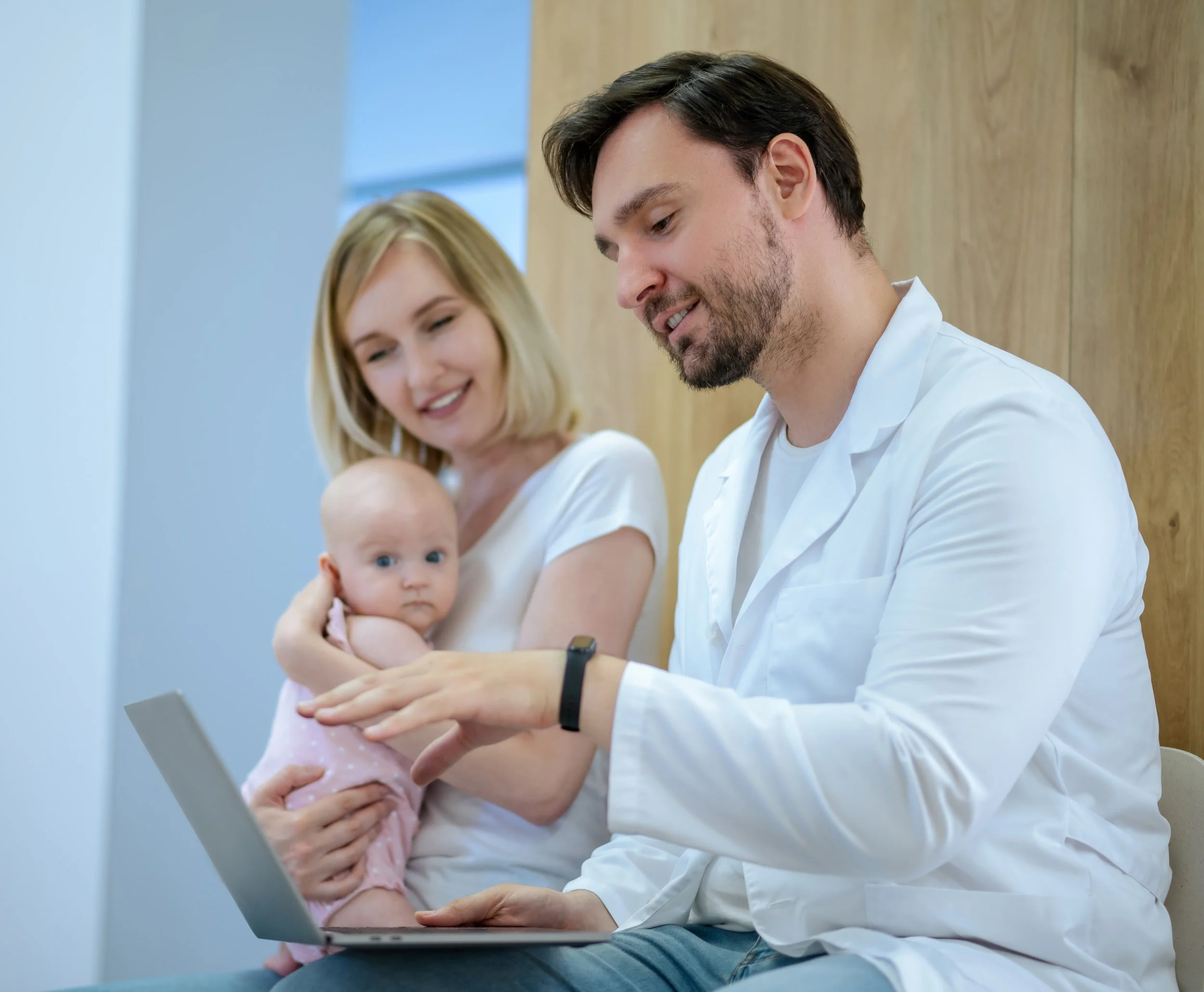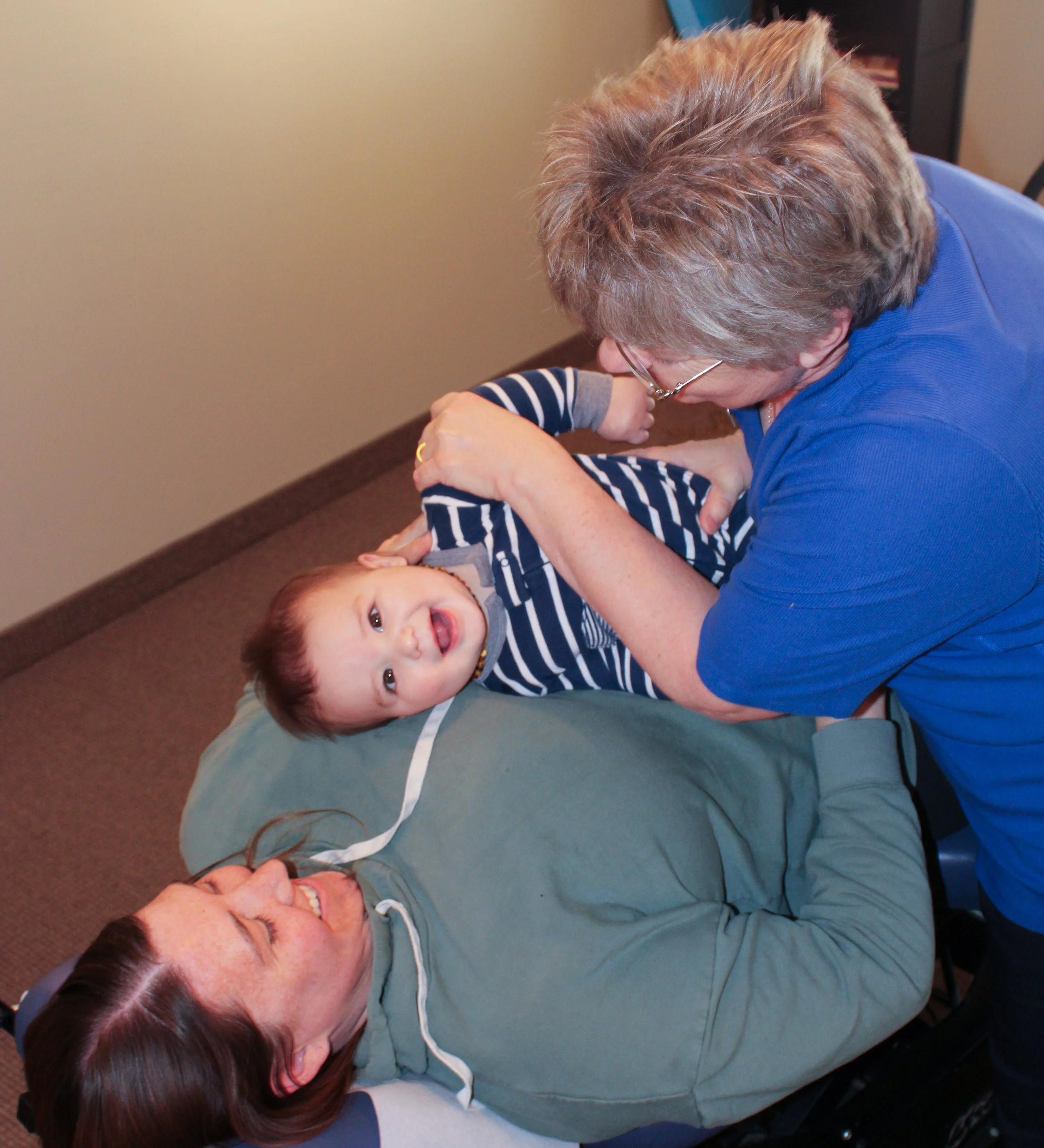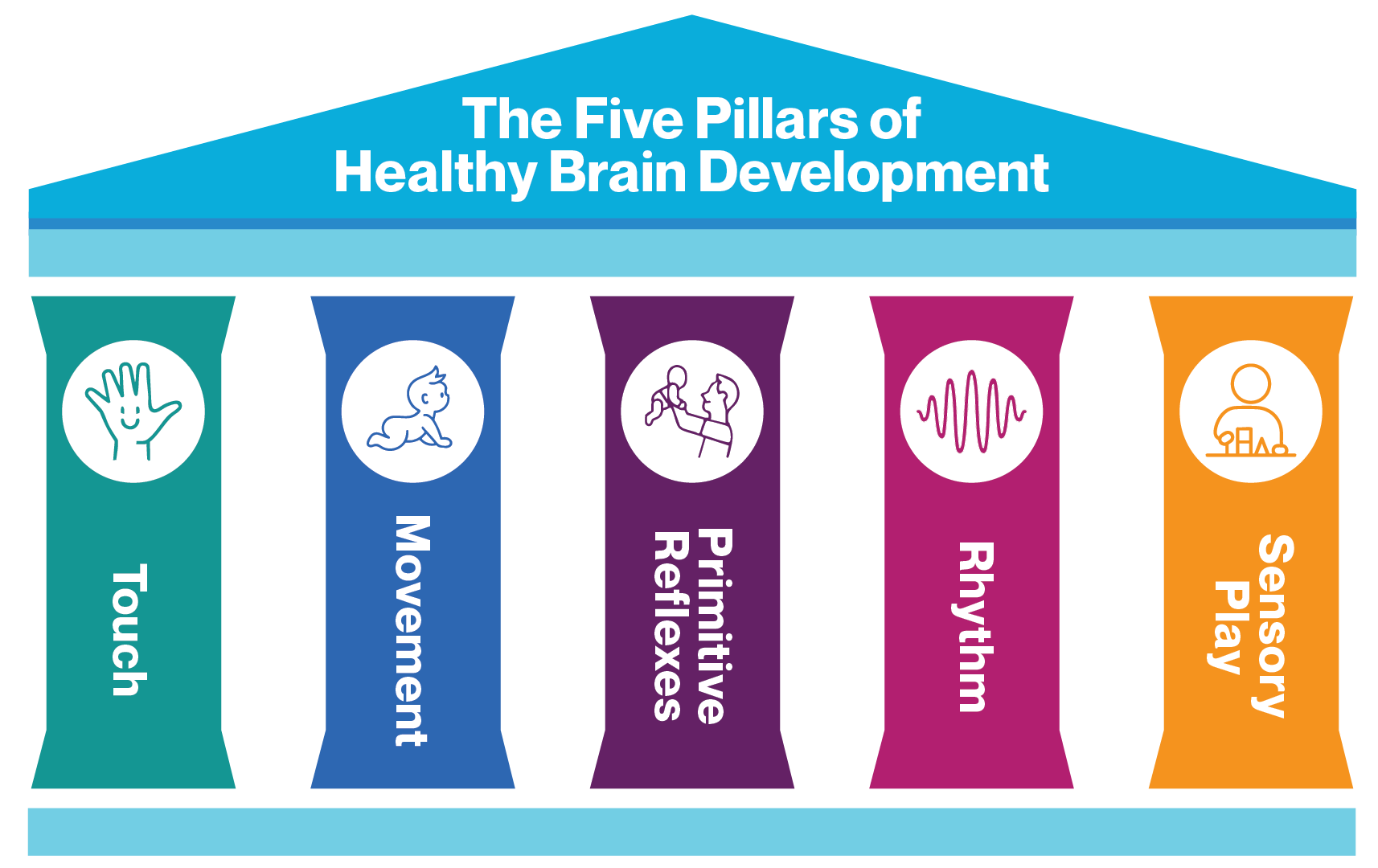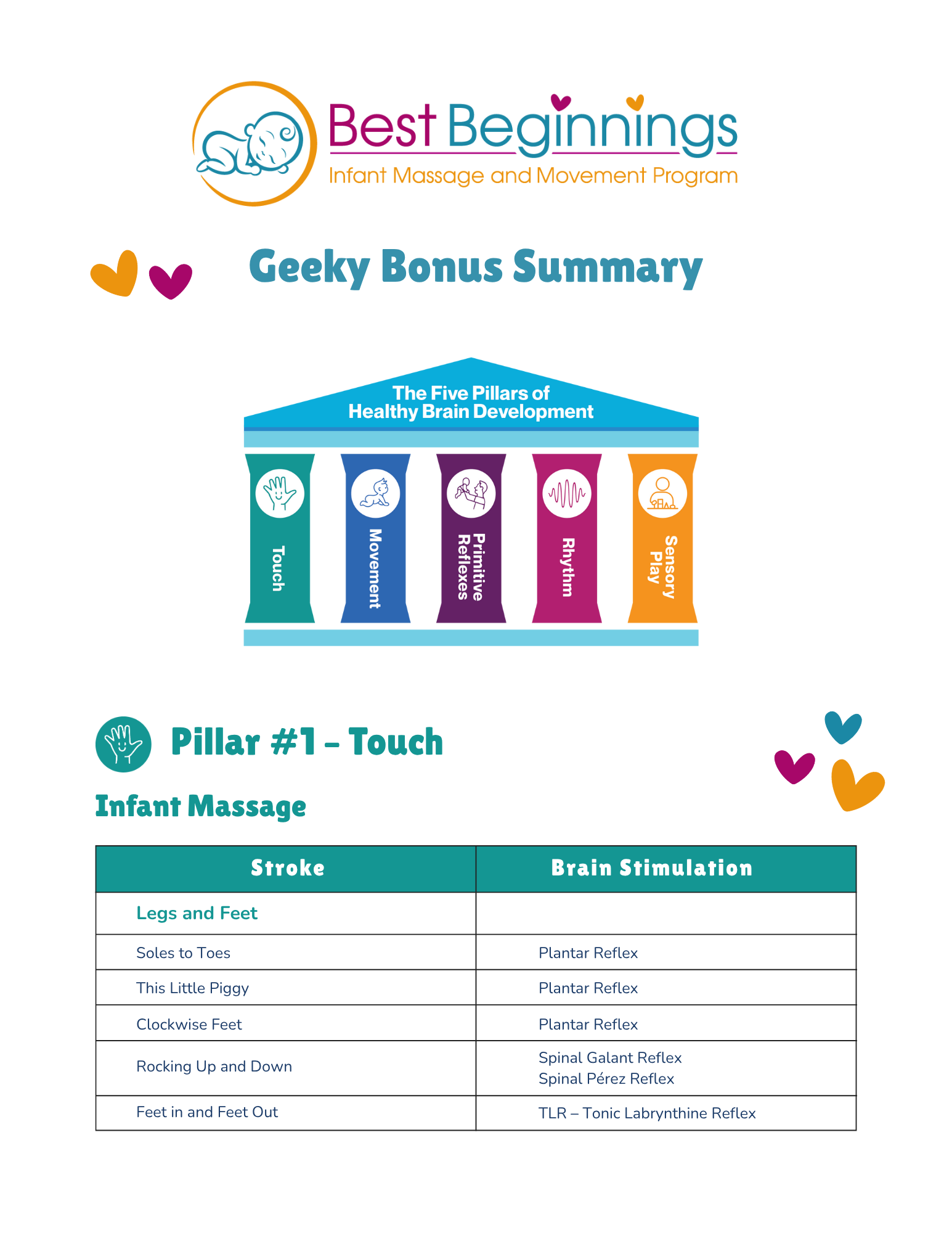
For Professionals
Many professionals who work with infants and children recognize that touch, movement, and the integration of primitive reflexes are crucial for healthy brain and body development. Early sensory and motor experiences shape lifelong learning, behavior, and emotional well-being.
The Best Beginnings Infant Massage and Movement Program gives parents research-based ways to support Baby’s brain development — helping professionals extend their care beyond the clinic.
How You Can Use Best Beginnings
Many practitioners share the Best Beginnings Program with parents as an extension of their own care plans. Others use it to educate staff or as part of prenatal or parenting classes.
Ways to collaborate
Refer families to the Best Beginnings course for at-home guidance
Integrate massage and movement education into parent workshops
Use the printable guides as teaching tools for postpartum visits
Connect with Dr. Melanie to discuss continuing-education or guest-speaking opportunities
About Dr. Melanie Beingessner
Dr. Melanie has spent over 25 years working with families in Airdrie (North Calgary), Alberta, integrating chiropractic care, infant massage instruction, and parent education at Blessingways Family Wellness, her multidisciplinary family clinic.
The Five Pillars of Healthy Brain Development
Best Beginnings is built on five interconnected pillars that reflect key areas of early neurological growth. Understanding these areas helps professionals explain to parents why touch and movement matter so deeply in Baby’s first year.
Touch – The Infant Massage Pillar
This is the infant-massage part of the program. Gentle, rhythmic touch provides many benefits for Baby and for the person giving the massage.
Infant massage helps to:
Improve bonding and secure attachment
Enhance sleep quality and relaxation
Support breathing and oxygen exchange
Decrease gassiness and fussiness
Improve digestion and bowel movements
Promote healthy weight gain
Each stroke and rhythm offers sensory input that strengthens Baby’s nervous system and supports early emotional regulation.
Movement – Building the Brain Through the Body
Proper movement is key for brain development. This section explores how sensory input and movement work together to shape Baby’s coordination and learning.
Professionals and parents will learn about:
Proprioception – how Baby senses body position and movement
The Vestibular System – how balance and motion develop
The importance of tummy time and floor play
Specific movements that stimulate primitive reflex integration
Ideas for movement and play activities that enhance Baby’s development
These natural, playful movements help organize the brain for later milestones like rolling, crawling, and reading readiness.
Primitive Reflexes – The Foundation for Learning
Primitive reflexes are automatic movements that help Baby eat, breathe, and begin to move. Integrating these reflexes is essential for healthy brain development and body control.
This section explains how early reflexes shape Baby’s development. Professionals and parents will learn about:
What primitive reflexes are and why they are important
How reflexes integrate as Baby gains new motor skills
What happens when reflexes do not integrate fully
The eight key primitive reflexes and their roles in growth
Common behaviors and learning challenges linked to retained reflexes
Recognizing and supporting reflex integration helps Baby build the foundation for balance, focus, coordination, and emotional regulation.
Rhythm and Sound – Organizing the Brain Through Pattern
Rhythm helps Baby’s brain make sense of the world. Gentle, predictable patterns of touch, movement, and sound create a sense of safety and help organize the nervous system.
This section explores how rhythm supports communication, calm, and connection.
Professionals and parents will learn about:
Rhythmic touch and how it soothes Baby’s body and mind
Rhythmic movement that promotes balance and coordination
Rhythmic sounds that stimulate Baby’s auditory and language centers
The importance of sound for early speech and brain development
Simple rhythmic activities and songs to help Baby relax and fall asleep
These rhythmic experiences strengthen the bond between Baby and caregiver while laying the foundation for language, listening, and emotional regulation.
Sensory Play – Learning Through the Senses
Sensory play helps Baby’s brain grow through exploration and discovery.
This section gives parents simple ways to engage Baby’s senses.
Professionals and parents will learn about:
The importance of sensory play for brain development
The five senses — touch, taste, smell, vision, and hearing
Why messy play and free play matter
How making a mess supports learning
Sensory experiences that can overwhelm Baby, such as loud noise or limited visual variety
Encouraging safe, varied sensory play helps Baby build curiosity, confidence, and focus.
Understanding the Link Between Early Development and Later Challenges
Professionals in many fields — medical doctors, chiropractors, optometrists, occupational therapists, teachers and early child development workers — are noticing rising numbers of children with learning and behavior challenges that often trace back to missed developmental milestones or retained primitive reflexes.
When the brain’s sensory and motor systems don’t fully mature, children may show signs such as:
Startle Reflex
mood changes
acts impulsively
afraid to try new things
trouble making friends
is often anxious, worried or nervous
Tonic Labrynthine Reflex - TLR
poor core strength
trouble with balance
difficulties focusing
clumsy or uncoordinated
difficulties playing ball sports
Plantar Reflex
grips the floor with toes when standing
loose ankles that sprain easily
doesn’t know where is in space
falls often
sensitive feet - doesn’t like socks or shoes
Rooting Reflex
sensitivity around the mouth
picky eater
messy eater
ongoing thumb sucking
difficulties speaking
Asymmetrical Tonic Neck Reflex - ATNR
did not crawl as a baby
robot-like gait
clumsy
holds a pencil too tight
mixes b’s and d’s when writing
Palmar Grasp Reflex
messy handwriting
awkward pencil grip
right and left confusion
thumb sucking after 18 months
eats with hands instead of a fork or spoon
Symmetrical Tonic Neck Reflex - STNR
skipped crawling, or crawled commando-style
struggles with ball sports
slouches or leans when sitting, holds head up
difficulties focusing or paying attention
difficulty copying from the board
Spinal Galant Reflex
fidgety, unable to sit still
trouble with focus
difficulties with reading
bedwetting past the age of 5
ticklish, low back is very sensitive, will squirm when back touches a chair
How many children with retained primitive reflexes
may be mistaken for having ADHD?
How Professionals Use Best Beginnings
For parent education: Recommend the program as a home resource to complement clinical care.
For workshops and classes: Integrate the movement program into prenatal or early childhood sessions.
Every component is evidence-based and easy for families to implement at home, providing continuity of care and reinforcing your clinical recommendations.
Collaborate and Learn More
Dr. Melanie works with chiropractors, health professionals, educators, and birth professionals who share her passion for early brain development.
If you would like to explore collaboration, or group access options for your clinic or organization, please contact us.
Together, we can help every baby get the Best Beginning possible.













